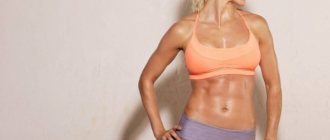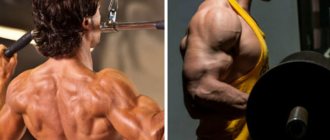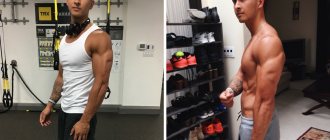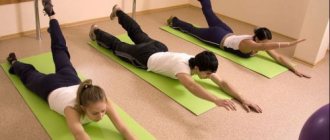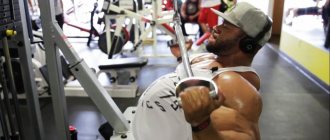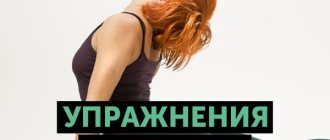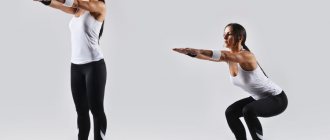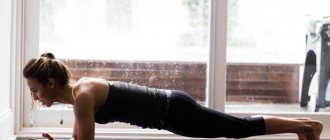How to pump up your lats
There are two types of wing loading:
1 Developing muscles in width. 2 Developing muscles in thickness.
There are separate exercises for each of these groups. It is worth remembering that wings are a fairly large muscle group, and to work them effectively you need to include exercises from both categories.
The lats are located on the back and occupy a significant part of it. This means that by performing basic back exercises such as deadlifts or bent-over rows, you will develop this muscle group. But there are others who purposefully develop wings.
Lat exercises to develop width are performed in the vertical plane. These include all types of pull-ups and vertical rows.
To develop thickness, use various types of dumbbell rows in an inclined and standing position, barbell rows and lower pulleys .
For width:
The role of technology in wing inflation
For most bodybuilders, the correct feel and technique for performing exercises for the latissimus dorsi muscles comes over time during training. And although the thickness develops quite quickly, the width of the wings appears later.
The problem lies in using the wrong technique when performing various back extension exercises. The technique of creating inflated wings requires understanding and a lot of practice to master.
During all back exercises, especially the latissimus muscles, the biceps receive the greatest load. You can't do just your wings and not use your biceps. Most beginners rely almost exclusively on biceps strength to perform the wing exercise, which limits the results they can expect to get from their back workout.
The secret is to limit the involvement of your biceps as much as possible. As with a strong forearm, they must perform a secondary action during exercise.
How to achieve this? The hand should look like a hook or cup that holds the barbell. Thoughts should be focused on the fact that the exercise is performed by the back, not the biceps. For most beginners, this is very difficult because they cannot ignore the fact that the biceps is the muscle that is involved in any pulling exercise.
Doing latissimus dorsi exercises correctly requires visualization and practice, otherwise you simply won't be able to achieve maximum results.
The only way for most bodybuilders to perform wing exercises correctly is to practice form and pumping technique with light weights. Once you have mastered the technique, you can begin to add weight to the exercises.
Pull-down of the upper block behind the head
Increases strength and allows you to build muscle mass in your lats. Effective for girls and beginners, as it allows you to strengthen your back before developing other muscle groups.
- Sit on the bench, set the desired weight.
- The bar is taken with an overhand grip.
- As you exhale, lower the bar behind your neck, approximately to the beginning of the trapezius level.
- As you inhale, return the bar to its original position. Don't forget about proper breathing.
Vertical row on the block with one hand
Making a difference
What sets this movement apart from others is that it is unilateral, which promotes balanced muscle development (on each side); if one side of the lats is lagging behind the other, regular one-arm rows will allow the weaker side to grow and catch up with the stronger side.
Performance
Attach the D-handle to the cable of the machine. While seated, grasp the handle with one hand and begin by keeping your torso straight with your palm facing the midline of your body (neutral). Place your non-working hand on top of the knee support bar. Bend your elbow and pull the handle down until your arm is below chest level. Slowly return to arm's length position. Repeat the movement as many times as necessary, then change hands.
Classic pull-ups
The exercise is rightfully considered the best for developing wing width. If it's easy for you to perform the required number of repetitions with your own weight, use additional weights in the form of plates or weights.
- Hang on the horizontal bar, straight grip, arms as wide as possible.
- As you exhale, pull yourself up, using only muscle strength - do not swing or jerk.
- Hold at the top for a second and slowly, as you exhale, lower down.
Pull-ups can also be done with a reverse grip. In this case, part of the load will be transferred to the biceps of the arms, which will make the exercise easier.
You can develop the width of the latissimus dorsi muscles both on simulators and exclusively on the horizontal bar.
For thickness:
Kinesiology of the latissimus dorsi muscles
Before you take on weights and pump your wings, you should understand the functional features of the structures of these muscles. The latissimus dorsi muscle attaches to the medial side of the intertubercular groove of the humerus, and originates from the third lower rib.
Any discussion of the latissimus dorsi must include mention of the teres major muscle. It is called the “little helper” of the wings because they both have the same effect on the arm, and it is impossible to train one muscle without the other.
Bent-over barbell row
It is a basic exercise and also the best for developing the thickness of the back muscles. To do it:
- Equip the barbell with the required weight and place it in front of you.
- Take it with a forward or reverse grip and stand up straight.
- Tilt your body forward to approximately 45 degrees. Keep your back straight - a natural arch in the lower back is allowed.
- Bend your knees slightly.
- As you exhale, pull the barbell towards your lower abdomen and hold it for a second.
- As you move up, try to squeeze your shoulder blades together as much as possible.
- As you inhale, straighten your arms with the barbell and lower it to your knees.
During movement, the bar rises exclusively in the vertical plane.
Bodymaster.ru recommends Training Plans:
The teres muscle originates in the lower part of the shoulder blade above the latissimus dorsi. It is attached to the head of the humerus in almost the same place as the latissimus dorsi muscles. Its task is to expand, internally rotate and adduct the shoulder joint.
The functions of the latissimus dorsi muscles are very important: this muscle group is actively involved in adducting the humerus. Whenever our arms are overhead, such as when performing lat pulldowns or pull-ups, the wings force the shoulder blades down and stretch the entire shoulder girdle.
Pulldown to the chest on the upper block
Weighted pull-ups
And any exercises in which the arms pull down bring the wings into full contraction. Basic rows and pullovers with dumbbells or barbells are also great for developing and pumping up your wings.
Bent-over dumbbell row
It can be performed similarly with a bent-over barbell row or alternately for each arm in different positions. Let's consider the classic option using a bench.
- Place the bench horizontally.
- Take a dumbbell with the required weight in your right hand.
- Place your left palm and left knee on the bench.
- Your back should be straight, your right arm hanging freely with the dumbbell at the side of the bench.
- As you exhale, lift the dumbbell up, focusing on the movement of the shoulder blade.
- The higher you raise your elbow, the more intense the load will be.
- As you inhale, gently lower the dumbbell to the starting position.
Features and rules of effective training
Exercises with a barbell can be performed by people for whom compression load on the spine is not recommended. However, to avoid injury, several rules must be followed. How to pump your back and stay healthy:
- monitor the work of the muscles, since traction should be carried out with the back and rear deltas;
- adhere to a moderate pace without sudden or, conversely, too slow movements;
- control every action (from the moment of raising to lowering the bar), you cannot suddenly drop the projectile;
- Before starting the workout, warm up each ligament, and only then do working approaches.
Some beginners pay attention only to the latissimus muscles. In this case, the back will be pumped unevenly or pain will appear from overexertion. In fact, a man needs to work 3 zones with a barbell: upper (trapezius, rear deltoids), middle (latissimus and extensor muscles) and lower (lower back). In addition, diseases of the musculoskeletal system may occur due to improperly distributed load during training.
There are a lot of advantages to doing back exercises with a barbell, and the main one is that you can do it at home; you don’t need anything other than equipment. It is possible to train many areas by choosing different deadlift styles. When performed correctly, there is no load on the spine, which means that even people with spinal diseases can pump up muscles. After just a few weeks of regular exercise, progress will be noticeable: an increase in strength, muscle volume, and physical endurance.
Horizontal block thrust
Performed in the gym, it promotes the active development of strength and thickness of the lats.
- Set the required weight and sit on the bench.
- Grasp the handle with both hands.
- Throughout the entire approach, you need to keep your back straight and not lean your body forward.
- As you exhale, pull the handle towards your abdominal area, trying to squeeze your shoulder blades together as much as possible.
- Stay in this position and return to the starting position.
There are many variations of both dumbbell rows and horizontal rows. Read more about how to perform these exercises in other articles on our website.
Basic exercises for developing the lats include bent-over barbell rows and pull-ups. These are the ones you should focus on first.
Exercises for pumping up wings
If your figure resembles a rectangle, oval or even a circle, pull yourself together and pump up your latissimus dorsi muscles so that the mirror shows you the ideal proportions! Pull-ups, barbell or dumbbell rows, T-bar rows and pull-downs on a block - these exercises are considered bodybuilding classics in pumping up wings.
T-bar row
Belt row on the block
However, in order for you to be guaranteed to get results and not waste time in the gym, it is important to follow the correct technique. This will allow you to use only the necessary muscles and protect you from injury.
How to pump up your wings on the horizontal bar
Lat training can be done exclusively with the help of a horizontal bar. True, in this case you will work exclusively on their width, practically not developing their thickness.
Classic pull-ups are the best way to train using a horizontal bar. Other types of pull-ups and movements on the bar can only become an additional load to diversify the training process.
As you progress, use additional weights to stimulate active muscle growth.
Back - exercises and training features[edit | edit code]
Yuzhakov Anton BEST EXERCISES FOR LATISM MUSCLES
The best exercises for the back
Back muscles: 1 - trapezius, 2 - latissimus, 3 - erector spinae Bodybuilding. Authors: R. T. Raevsky Bodybuilding. Authors: R. T. Raevsky
Training the back muscles contributes to the development of its V-shaped relief shape, which makes the waist and hips visually narrower, thereby making the figure look more aesthetically pleasing. The back muscles are large muscles, which makes them one of the main ones in bodybuilding, since without well-developed back muscles you will not have a harmonious figure, and your strength in squats or deadlifts will remain low.
Developed back muscles are also very important for the formation of correct and beautiful posture, since these muscles play a major role in stabilizing the spinal muscles.
It is due to the low tone of the trapezius muscles that the shoulders are retracted forward and a stoop develops. Read more:
- Posture correction – biomechanical basis of postural disorders.
- Stage 1 – general recommendations for changing lifestyle and movement patterns.
- Stage 2 – gymnastic exercises and stretching, necessary to eliminate muscle hypertonicity and mobilize the musculoskeletal system.
- How to correct posture (exercises) - building strength training aimed at strengthening target muscles.
Anatomy and functions[edit | edit code]
Read more:
Back muscles
The back muscles are located in several layers, so they are divided into deep and superficial, which, in turn, are also located in two layers. The appearance of the back is determined by three main muscles: the latissimus muscles, the trapezius muscles and the lower back muscles.
How to pump up your wings with push-ups
You can also pump up your wings at home with push-ups. Disadvantages of this method: to perform it correctly, you will also need developed shoulder and triceps muscles, and also the fact that you work exclusively with your own weight.
To pump up the latissimus muscles with push-ups:
- Take a lying position.
- Spread your arms as wide as you can.
- Keep your back straight.
- Lower yourself by bending your elbows.
- Touch the floor with your chest and return to the starting position.
A special feature of the lats is that they are divided into two categories according to their functions. And for their uniform and high-quality development, it is necessary to include in the program exercises included in both categories.
Is a special machine required for back training?
The hyperextension machine is a small frame with pads attached to it under the hips and rollers that fix the ankle.
There are quite a few options for performing hyperextension at home - it can be done on the sofa (for this, your partner must support your legs with their own weight), on a small table or wide stool with your feet resting against the wall, on a fitball, pillows, or a cushion from the sofa. The main thing is to fix your legs and raise your torso, and then the matter is limited only by your imagination.
However, such improvised simulators have one common disadvantage - unreliability, and, consequently, the danger of injury. You rolled off the fitball, the roller shook, the table leg broke, your partner got distracted and you fell face first into the floor - and now this seemingly therapeutic exercise has become the reason why you will have to temporarily forget about training.
A high-quality exercise machine is a stable design designed to perform this particular exercise, which will not let you down at a critical moment. Stability is especially important for people with significant excess weight, beginners who are just mastering the technique and cannot boast of good coordination, as well as advanced athletes who begin to perform hyperextensions with additional weights - weights from a barbell, dumbbells or other weighting material.
In addition to the obvious health benefits, the exercise machine provides the following advantages:
- Space saving. Hyperextension is one of the smallest exercise machines; it fits perfectly into small apartments; there are even collapsible options that do not take up any space.
- The adjustable size makes training convenient for the whole family.
- The variable angle of inclination will provide maximum amplitude of execution, and will also allow you to work your back at different angles, reduce or increase the load if necessary.
- Soft bolsters and thigh supports protect your legs from abrasions and bruises that are inevitable when exercising on improvised equipment.
- Can be used for other exercises - abdominal crunches, side bends for the obliques, biceps curls, rows and dumbbell swings - for the latissimus and posterior deltoid muscles.

